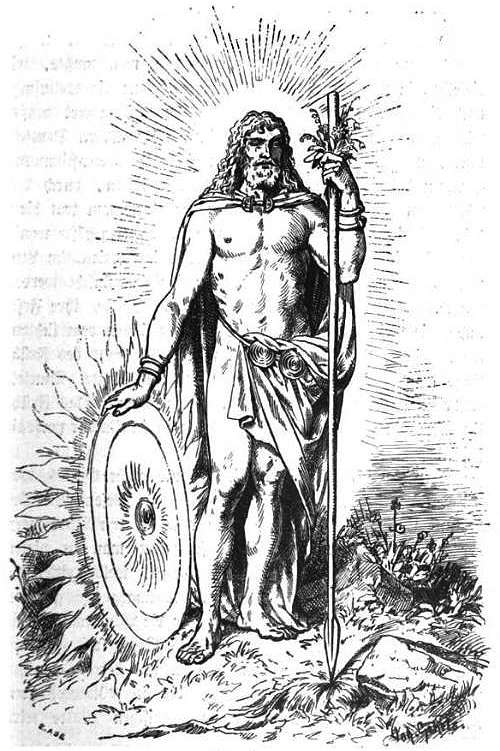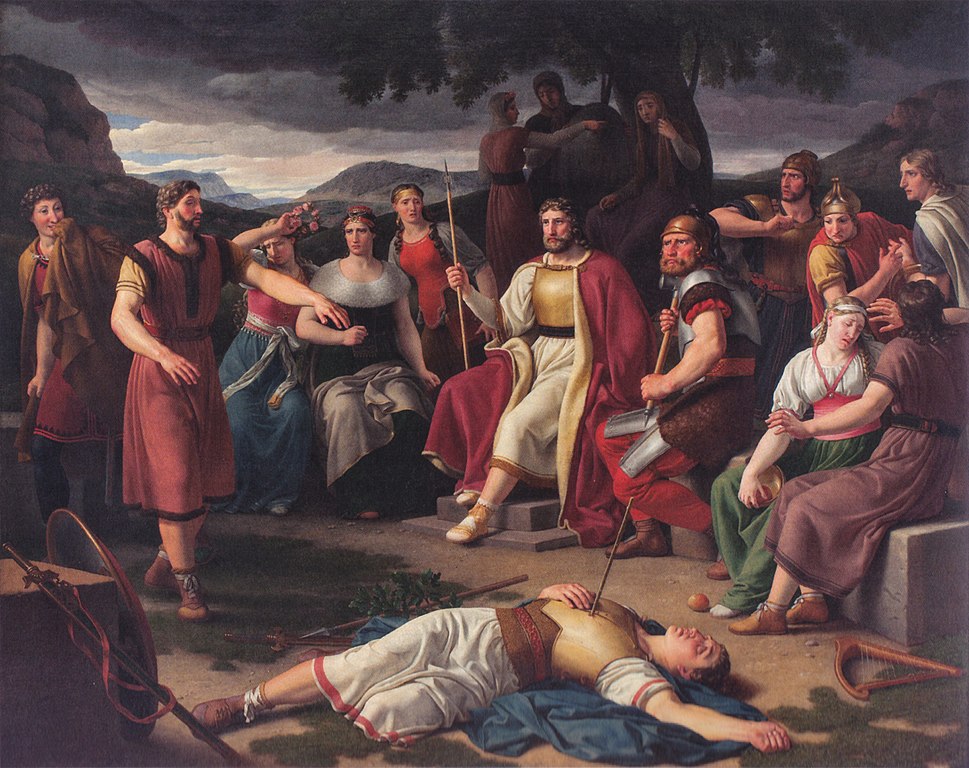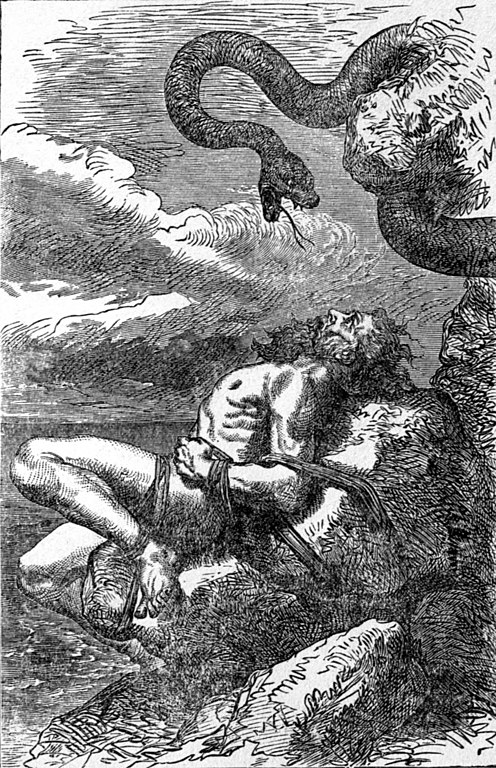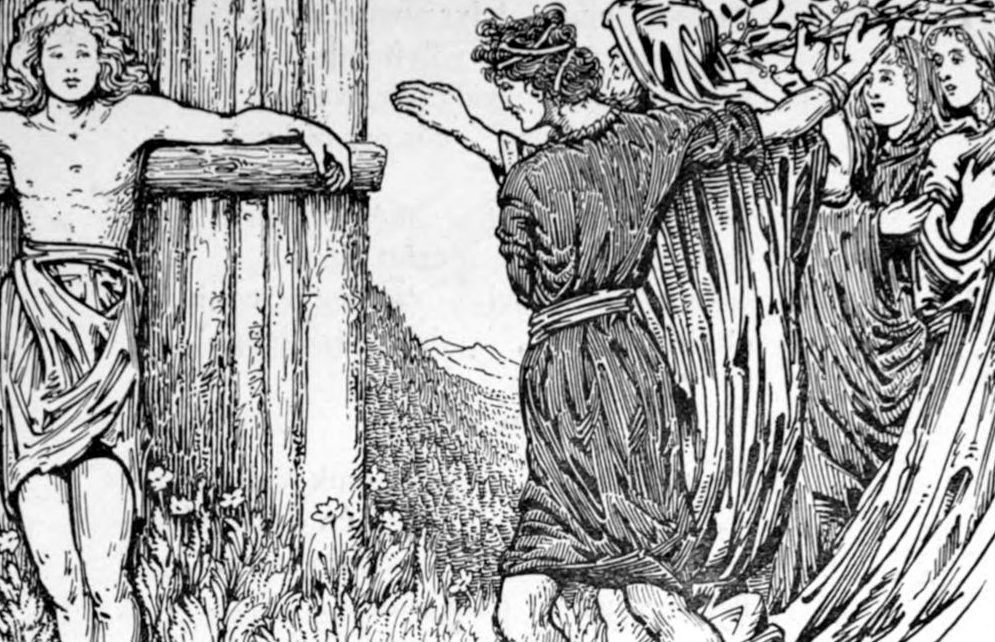Baldr (also known as Baldur or Balder) is the son of Odin and his wife, the goddess Frigg in Norse mythology. All gods and human beings loved him as he was so generous, handsome, and good.
When his mother heard a prophecy that her favorite son would be killed, she made every animate and inanimate object in the nine realms promise they would never harm Baldr.
What Is Baldr God Of?
Baldr is called the “gleaming” god of light, joy, and purity.
What Does Baldr Represent In Norse Mythology?
Baldr represents light, joy, and purity. He was handsome, generous, and had a kind nature – gods and mortals loved him in equal measure.
Baldr’s death is the catalyst for a chain of events that culminates in Ragnarök, the Norse end of the world.

Baldr’s Relation To Other Norse Gods
Baldr’s father is Odin, the supreme Norse god and Allfather of Norse mythology. His mother is Frigg, the most important Norse goddess. She used her magic to make every living thing and inanimate object in her world promise never to harm Baldr.
Baldr’s twin brother is the god of darkness, the blind god Höðr. Due to Odin’s “wandering eye,” he also has many half-brothers, including Thor, Týr, Heimdall, and Hermóð.
Odin and the giantess Rindr conceived Váli, another half-brother, to kill Höðr to avenge Baldr’s death. Váli reached full maturity in one day.
Rind bears Vali
Baldr’s Draumar – Voluspa Org
in Vestrsalir,
And one night old
fights Othin’s son.
Baldr and his wife, Nanna, had a son called Forseti, the god of justice and reconciliation in Norse mythology.
The Death Of Baldr
Baldr’s life and the story of his death (and beyond) are spread over different tales and poems. They are sometimes not in a logical chronological order.
Baldr’s Dream
Odin, concerned by his son Baldr’s nightmares, held a council to discuss them. He then journeyed to Hel to exhume a deceased völva whom he believed could reveal why his son was suffering from bad dreams.
In one tale, the völva told Odin (who she believed was the traveler Vegtam) that she had seen Baldr bleeding in her dreams. In another, she said to him that Höðr would kill Baldr and that Váli would avenge his death by killing Höðr.
Loki and the Mistletoe
Loki transformed himself into an old woman and tricked Frigg into revealing she had omitted to include mistletoe in her list of things that could not hurt Baldr.
While the gods tested Baldr’s immortality by throwing various objects at him, Loki devised a plot. He made a spear out of a branch of mistletoe and convinced the blind Höðr to throw it at Baldr. Baldr was killed instantly when struck by the spear.
Frigg held her dead son in her arm and wept. In her grief, she asked if anyone would go to the realm of Hel – Helheim – to strike a bargain with the ruler, Hel, to allow Baldr to return from the dead.
Hermód (or Hermóðr), at Frigg’s request, rode to the realm of the dead on Sleipnir to ask for Baldr’s return. After journeying for nine days, crossing the river Gjoll and managing to pass the maiden Módgunn, he arrived in Helheim. Hel agreed to allow Baldr to leave, but only if everything in the nine realms, dead or alive, wept for him:
If all things in the world, alive or dead, weep for him, he will be allowed to return to the Aesir. If anyone speaks against him or refuses to cry, then he will remain with Hel.
The Death of Baldr – Hrustwic Org

The Giantess Þökk
Everyone except Þökk, a giantess, shed a tear for Baldr despite the Æsir doing everything they could to convince her. She said, “Alive or dead, the old man’s son has been no use to me. Let Hel hold what she has.”
Consequently, Hel refused to let Baldr leave. We learn that the giantess Þökk was actually Loki in disguise.
Later, the trickster god Loki and Frigg argued while in the hall of Aegir, and Frigg told him that if her son Baldr were with them, he would kill Loki for mocking her. Loki hinted that he was the reason Baldr would never return to do that.
The Punishment of Loki
Loki had admitted his guilt and fled to a mountain where he built a house with a door in each of the four walls so he could spot any enemies approaching. Odin found him, but Loki tried to evade him by turning himself into a salmon at a waterfall called Franangrsfors. The Allfather caught him by the tail and imprisoned him, in human form, in a cave.
The Æsir gods brought his sons Nari and Narfi to the cave. They used Nari’s innards, which they changed into chains, to bind Loki, and turned Narfi into a wolf. The jötunn and goddess Skadi hung a snake above his head.
Loki’s wife, Sigyn, used a bowl to try and stop the venom from the snake from falling onto her husband. However, she had to empty it now and then, meaning the poison dripped onto Loki’s face causing him to convulse violently and cause earthquakes around the realms.

The beginning of Ragnarök
These earthquakes were one of the signs that preceded Ragnarök, and Loki would eventually break free from his bonds, sailing the ship Naglfar (“ship of human nails”) into the last battle. Fenrir, the giant wolf, would kill Odin, and Thor would die after the serpent Jörmungandr bit him.
Although some tales do not mention events after Ragnarök, later texts do. They describe the earth rising again, cleansed and fertile, although some areas are still foul and dangerous. Baldr and his brother Höðr return from Hel. Worthy people would live in a hall with a golden roof.
Baldr’s Attestations
Baldr appears in Gesta Danorum by the 12th-century Danish historian Saxo Grammaticus.
The Gylfaginning, from the Prose Edda, a compilation of Old Norse texts by the Icelandic politician, historian, and poet Snorri Sturluson mentions Baldr’s ship Hringhorni as the finest ever made. Breiðablik, his abode in Asgard, is exceptionally beautiful.
Baldr’s nightmares, Odin’s council, and subsequent journey to the realm of Hel are described in Baldur’s Dreams (Baldrs Draumar in Old Norse), an Eddic poem that appears in the manuscript called AM 748 I 4to.
Stanzas 31-35 of the Völuspá, the best-known poem in the Poetic Edda, narrate the story of the völva who told Odin about Baldr’s death:
I saw for Baldr,
the bleeding god.
She also mentioned Frigg’s grief:
But in Fensalir
The Poetic Edda – Sacred Texts
did Frigg weep sore.
Baldr appeared in Lokasenna. Loki was taunting Frigg about her promiscuity; Frigg answered, saying Baldr would kill Loki if Baldr were there.

